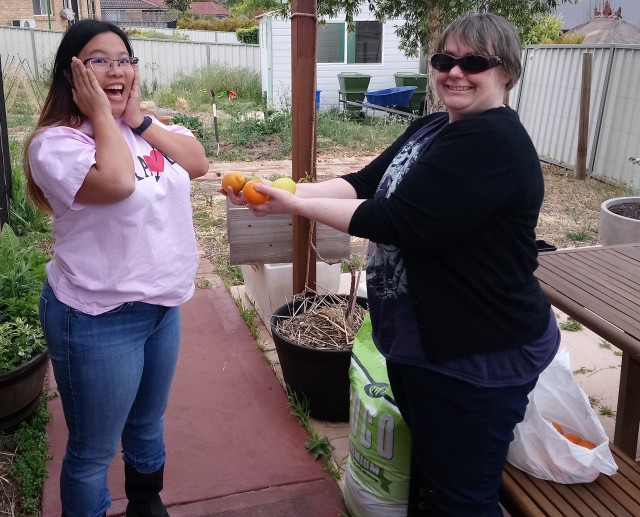Whilst J was busy rearing mealworms, Little E asked me if she could also keep a pet. It just so happened that one of my old schoolmates is a primary school science teacher (henceforth referred to in this post as Mrs Great), and she had access to some caterpillars. She offered to give Little E a few of them and I was so excited to have another opportunity to study some more little creatures up close!
The very next day, Mrs Great rocked up with a clear tupperware that had four spiky black caterpillars, each about a centimetre long, happily nibbling away on spray of lime leaves. I don’t have a lime plant at home, so I was a little bit worried about having enough leaves for all the caterpillars – but Mrs Great assured me that there were probably enough leaves to last the caterpillars about two weeks.

Some Very Hungry Caterpillars in different stages of maturity
The next day, about half the leaves were gone, and the little black caterpillars had doubled in size, developing streaks of bright green. There were also little dry balls of caterpillar poo rolling about the bottom of the tupperware, which I emptied out into a flower pot on my balcony. This wasn’t a particularly nasty job as everything smelled pleasantly of lime juice.
On the third day, one of the caterpillars had turned a bright green and was the size of my little finger. It was eating up the lime leaves at an alarming rate. I sent a text message to my friend Mrs Great, who was kind enough to drop by with a bunch of lime leaves, but I knew that at the rate the caterpillars were going, I would definitely need to find more lime leaves before the end of the week.
Sure enough, by the start of the fifth day, it was clear that I would need to find more lime leaves for the caterpillars or they would certainly starve.

Running out of leaves!
Unfortunately, I went to three different supermarkets and three different wet markets and nobody had any lime leaves for sale! By this time, Little E was nearly in tears, upset that her caterpillars might starve to death.
However, as I was driving home, I passed by my local community garden. I stopped by, hoping against hope that I would find the leaves that I needed.
I didn’t think I’d be able to identify a lime plant without it’s signature green fruit, so I ran around taking pictures of various little plants and sending them to Mrs Great for identification. Fortunately, one of the pot plants had a tiny little green lime hanging on the one of the stems! Hooray! Community gardens save the day!
I plucked off a spray of leaves and triumphantly brought it to Little E who was waiting in the car for me.
The Aged P also went to talk to the security guard of her flat who keeps a variety of plants in his little guard outpost – and he so happened to have a lime kaffir plant that he was carefully cultivating. She managed to convince him to part with a few leaves which I kept in a cup of water to keep them fresh.
I was almost down to the last spray of lime kaffir leaves when we noticed that the caterpillars had stopped eating and were curling up on themselves, wiggling very slowly. One by one, they each moulted one last time, forming chrysalids that were securely fastened to the sides of the tupperware by silken threads.

The Chrysalid and the Lime Butterfly
About a week later, the first butterfly emerged from it’s chrysalis! Little E was so excited, watching it pump it’s wings to fully inflate them and dry them out. We released it on our balcony and it rested there for a few hours before fluttering off.
As for the other three chrysalids, we noticed that all three had turned translucent one morning – we could see the black and white butterfly wings folded up beneath the surface of each chrysalis – so I told Little E to bring the tupperware to her kindergarten and share the magic of the butterfly with her classmates.
Sure enough the butterflies emerged from their chrysalids midway through her class time, much to the delight of everyone present. The teachers gently picked them up and released them into the school’s eco-garden, with Little E and all her classmates waving and yelling “Goodbye! Goodbye!”














 The
The 








